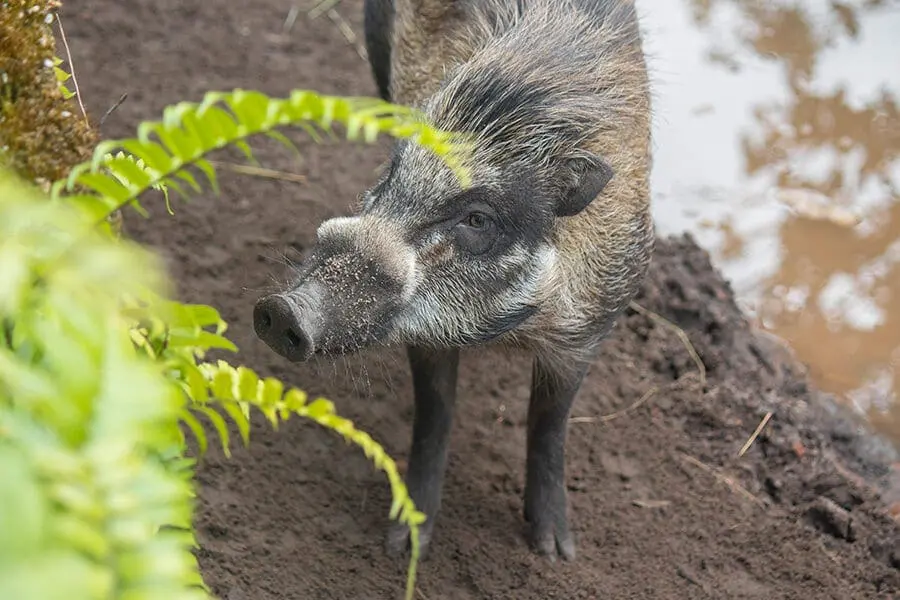

Meru traverses a creek in his yard.
In 1972, sisters Mary Lynne Rave and Ellen Stanley celebrated the first National Pig Day to recognize the cute, pink and surprisingly intelligent domestic pig. Though you’re probably quite familiar with this iconic farm animal, you may not know that it’s a descendant of the wild boar—just one of 18 pig species found throughout Africa and Asia.
Makina, Fancy, Baboy and Kulugo are our resident Visayan warty pigs, easily recognizable by their wild “mohawk” hair. These pigs have a talent for dispersing the seeds of several species of plants through their forest habitats. Historically found throughout the Visayan Islands in the central archipelago of the Philippines, Visayan warty pigs are now extinct in at least 98% of their former range. Widespread deforestation and interbreeding with domestic pigs has led them to critical endangerment, with only a few populations remaining on the islands of Negros and Panay. They are also subject to poaching by local farmers who view them as pests and a food source.

Baboy means “pig” in Filipino.
In 1992, Philippines Biodiversity Conservation Foundation, Inc. (PBCFI) established the Visayan Warty Pig Conservation Programme with the goal of reintroducing groups of warty pigs into areas of their natural habitat. Two captive breeding rescue centers have been established and PBCFI continues to research this poorly understood species and increase local awareness of the issues it faces.
Only 17 institutions in North America have North Sulawesi babirusas, so we are very lucky to be home to Meru and Piggy! The name babirusa translates to “pig-deer,” describing its appearance as a mix between a pig and a deer. Many regard them as some of the world’s most bizarre-looking mammals. Males have a pair of large tusks that curl toward their back as it grows. Babirusas are also relatively naked in appearance—they have just a sparse covering of hairs over their brownish-gray skin. They inhabit the Indonesian island of Sulawesi, particularly the northern peninsula, along the banks of rivers and lakes. North Sulawesi babirusas are considered vulnerable to extinction due to a long history of hunting by humans and, more recently, the expansion of large-scale commercial logging in the rainforests they call home. Lowland forest on the island has been reduced to 25% of its original cover, creating the dire need for conservation of the remaining habitat.
All species of babirusa are under full protection of Indonesian law and in 2013, the Indonesian government released a conservation strategy and action plan identifying 11 conservation sites on Sulawesi and banning international trade of the pig. Worldwide, the captive population is regulated by the Indonesian Zoo Association, the European Association of Zoos and Aquariums, the Association of Zoos and Aquariums and the International Union for the Conservation of Nature Species Survival Commission; these groups work together on a breeding program to maintain the genetic diversity of this species.
While every species of swine is worth celebrating, we especially love our pigs at the Zoo! As a not-for-profit organization that receives no regular government funding, every ticket, membership, food or retail purchase and donation goes directly towards caring for animals like Makina, Fancy, Baboy, Kulugo, Meru and Piggy. With your support, we can continue taking steps to preserve these special animals whose populations are struggling in the wild.
